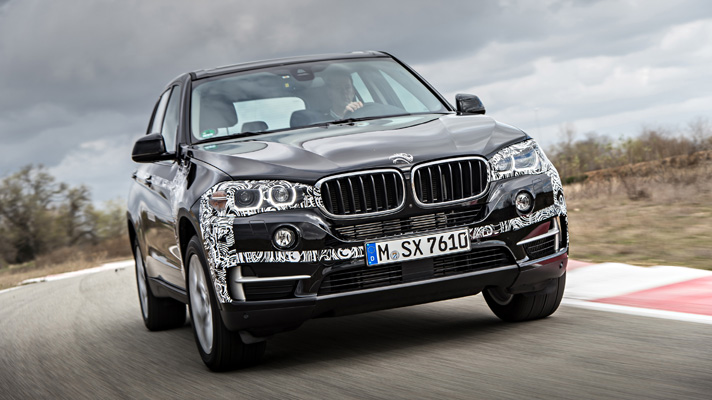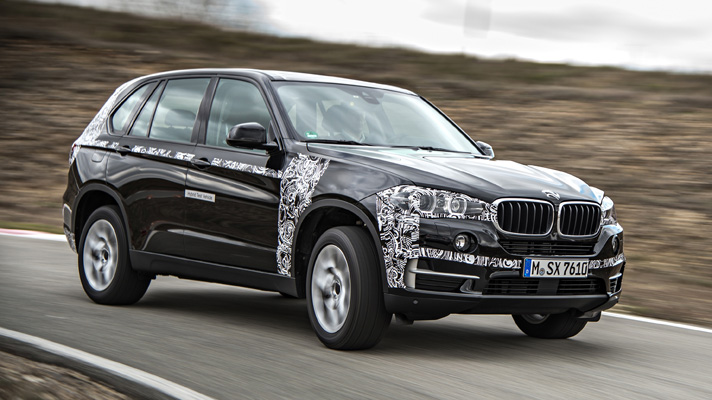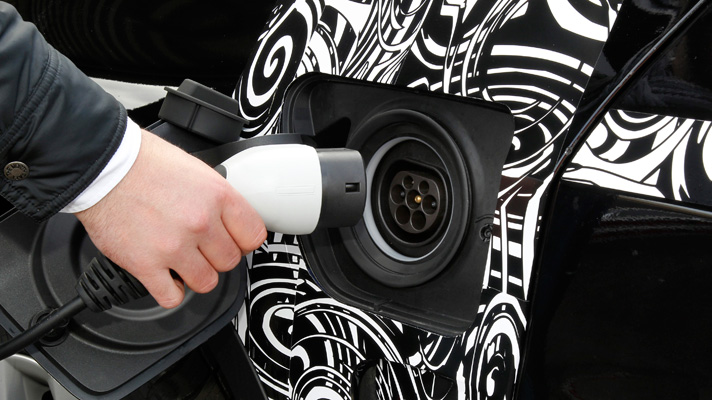
SPEC HIGHLIGHTS
- BHP
449bhp
- 0-62
4.9s
- CO2
224g/km
- Max Speed
155Mph
- Insurance
group46E
That's a perfectly ordinary 2013-model BMW X5 with a load of disguise tape on. Is this 2012 or what?
Nope. It really is a prototype for a car that isn't out until next year. Admittedly when it is launched it'll look just like the regular X5. But because it's a prototype powertrain, BMW paradoxically insists it has the zebra tape, even if that makes it more, not less, conspicuous.
So what is it?
The X5 plug-in hybrid, likely to be known as the X5 eDrive. It'll one of the first applications of i8 drivetrain technology to the main BMW lineup. It uses the same sort of battery as an i8 and it because it's got an electric motor to give a performance boost, the piston engine can be downsized. So in this case we have a two-litre four-cylinder petrol.
But from then on it departs from the mid-engined i8 formula. The engine's up front, and sends its output through the usual X5 eight-speed autobox and four-wheel-drive system.
A four-cylinder X5? Is going to be a bit of a slug surely?
It's not bad. You get the 240bhp 'N20' petrol engine from BMW's current 28i models. On top is a 70kW (94bhp) electric motor. You can't quite add the outputs because they hit peak at different rpms, but at best you have a total system output of 302bhp, which isn't at all shabby. That's when you combine the two in sport mode. They claim 0-62 in under 7.0 seconds.
And it feels pretty brisk too. Because the e-motor has instant torque it operates well at low revs when the petrol engine would otherwise be a bit dull-sounding and laggy. At higher revs it you hear a sporty petrol exhaust, albeit a four-cylinder not a six, sadly.
What about the green part of all this?
Well you can select a 'max eDrive' mode (nothing to do with driving an old Austin hatchback) which uses only electric power. This gives you near-silent progress, and the 94bhp is just about enough gumption to keep up with urban traffic. Anyway for times when you really need more acceleration to escape embarrassment, you can kick right down and the engine starts too. If you've plugged in and charged the 9KWh battery, you can eke out an electric-only official range of 21 miles. BMW research says that covers 80 percent of the journeys X5 owners drive.
Top Gear
Newsletter
Thank you for subscribing to our newsletter. Look out for your regular round-up of news, reviews and offers in your inbox.
Get all the latest news, reviews and exclusives, direct to your inbox.
Anyway, as a plug-in hybrid it consumes a combination of energy from petrol (which is counted) and energy from mains electricity (which isn't). In the official test cycle that will help get the production car drop under 90g/km, which means better than 70.6mpg.
How does it drive?
Electric performance isn't strong, but it is smooth and it'd be useful in snow because you can administer the torque gently, and it retains 4WD. In the hybrid modes, the petrol engine starts and stops virtually unnoticeably, and when it's on the boil you've got plenty of performance. Basically it mostly behaves as a 3.0 petrol X5 would, without any gaps in performance unless you go looking for them, for example by driving in eco mode then suddenly stomping on the gas. The four-cylinder engine sits well back in the bay, so the increased weight doesn't harm cornering, especially as there's BMW's computer-controlled 4WD system to distribute the torque. And in the modes where the petrol engine is harnessed, you have the towing grip and muscle of a regular 4x4.
How much increased weight are we talking about?
At this stage BMW won't say. Only that it'll be "the lightest in its class". What, lighter than the Mitsubishi Outlander PHEV, we asked? The engineers said they hadn't heard of the Japanese car, which is a typically German attitude. We assume therefore they mean lighter than the Porsche Cayenne e-Hybrid, which hasn't been launched yet, so how can they know? Anyway, the X5 eDrive adds a battery and electric motor and power electronics - all heavy - to the standard X5 30d. But as an offset, it drops two cylinders from the engine, and does without a torque converter. So the weight gain should be less than about 200kg. Not too crippling in a car that's already 2.1 tonnes.
Anything else clever?
When you programme a destination into the navigation, it looks at the route and works out how best to use the different power sources. So if you're approaching a big downhill, it will make sure some battery juice is used before the crest, so there's capacity to store the downhill regenerated energy. It also cuts the petrol engine early when it knows there's a speed limit ahead, again to harvest regeneration. And if your last few miles are in town, it will hold enough charge so the urban driving will be pretty well all-electric and you arrive with the battery depleted, ready to recharge cheaply. It even uses traffic information to work out your likely speeds along the route and emphasise petrol power at high speeds and electric at a crawl.
Featured

Trending this week
- Car Review
BMW 1 Series
- Top Gear's Top 9
Nine dreadful bits of 'homeware' made by carmakers






